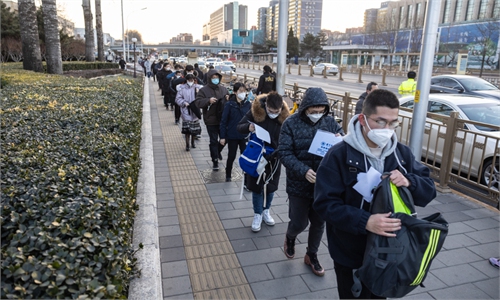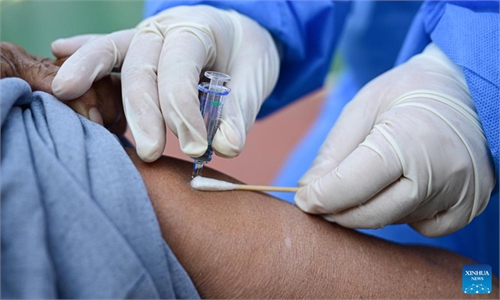
Shoppers queue to use self checkout services at Hema Fresh in Beijing on December 17, 2022. Photo: Li Hao/GT
China's National Health Commission (NHC) announced to stop publishing daily COVID-19 case data from Sunday and the duty now hands on to the Chinese Center for Disease Control and Prevention (China's CDC).Observers said handing over the epidemic data calculation to a technical organization is a reasonable move to provide professional epidemic figures.
"The NHC will no longer release daily epidemic data from Sunday. China's CDC will release relevant COVID-19 information for study and reference," the NHC said in a brief statement, without specifying the frequency for China's CDC to issue epidemic data.
Zhao Wei, a professor in the School of Public Health, Southern Medical University, told the People's Daily that the move indicates that it is already unnecessary to release epidemic information every day and the move will also help to shift more resources of related authorities to other key steps like clinical treatment.
Releasing epidemic information used to serve as a reference for the public so that they can avoid going to places that are encountering outbreaks. But as the epidemic has spread, releasing information everyday becomes unnecessary, Zhao explained.
In the future, the country will focus more on treating severe cases and reducing mortality. Data related to these aspects should still be precisely calculated and released, according to Zhao.
Entrusted by the CDC, Peking Union Medical College conducted a survey on national infection situation on China's Twitter-like Sina Weibo that finished on December 21 with about 470,000 people participating. The college is analyzing the results, which would serve as a vital reference for the country's epidemic management measures, Weibo announced Sunday.
A second round of survey is being carried out from 6 pm Sunday to 12 midnight Tuesday, according to Weibo.
Turning over the epidemic data calculation to the CDC, a technical organization that specializes in health data evaluation through multiple methods, including the use of statistical models to extrapolate data, is reasonable, because daily COVID-19 case data from the NHC cannot reflect the country's real epidemic situation since China has scrapped mass nucleic acid testing as part of its optimized COVID-19 response measures, a senior expert close to the China's CDC told the Global Times on condition of anonymity.
It is believed the CDC will largely rely on COVID-19 data reported by clinical diagnosis in medical institutions and monitor overall epidemic trends, Besides that, the technical organization has mapped out a range of new monitoring mechanism to replenish its epidemic reporting system, aiming to make the data more accurate and serving as a reference for the public to understand infection risks and local governments' response to the COVID-19 epidemic, the expert told the Global Times.
One of the important data sources to assist the understanding of the real infection rate will be coming from the online survey conducted by the CDC through text messages and App. Moreover, the CDC has arranged sample surveys among certain populations, certain regions and the country to acquire and calculate new infections and tally, the expert noted.
China's NHC began to release the daily new tally from January 21, 2020 when epidemic experts identified that the virus could spread from between humans and the country decided to classify the COVID-19 as a Class B infectious disease but managed like a category A disease. Medical institutions at all levels and of all types are required to lodge direct online reports through the China disease prevention and control information system within a specified time after diagnosing COVID-19 patients or suspected infections.
The daily COVID-19 figures guarantee the public's right to stay informed about the state of the epidemic and then make according adjustments to their work, life and travel. It also serves as a source of guidance for local governments to put in place reasonable COVID-19 prevention and restriction measures.
In line with the deeper understanding of the asymptomatic infections, the country adjusted epidemic control and prevention reporting mechanism, followed by new cases of asymptomatic cases being included in daily figures starting from April 1, 2020. Medical institutions are required to report silent cases within two hours once they are detected.
The anonymous expert close to the China's CDC told the Global Times that medical institutions across the country have been playing a key role in reporting new cases in past years but now they are embracing pressure in receiving COVID-19 patients, therefore, reporting new cases within two hours becomes a difficult task in nature.
Medical institutions will only have to report COVID-19 cases in 24 hours if the country downgrade management of COVID-19 to Class B in the future, other than the current within two hours as now the COVID-19 is managed like a category A disease.
It will take days for the CDC to activate the epidemic monitor reporting system and allows the organization to collect and report infection data effectively. As for how frequently will the CDC update the epidemic information, including the COVID-19 tally, the organization will roll out the plan in coming days, the expert said.
The surge of infected friends, colleagues and family members and the long lines at the fever clinics at hospitals across the country are all indications that the Chinese cities are experiencing infection peaks shortly after the 10 new optimized COVID response measures were released.
The new daily tally in East China's Zhejiang, for example, has surpassed one million, local authorities said on Sunday. The local epidemic monitor and community sampling survey predicted the peak caseload in Zhejiang will arrive in advance and enter the high plateau period around the New Year, during which the maximum number of newly positive cases will reach two million per day.
East China's Qingdao on December 23 predicted that the city is in the stage of rapid transmission before a COVID-19 spike and is currently seeing daily new tally between 490,000 and 530,000. The prediction in South China's Dongguan showed the city's infections are increasing at the scale of 250,000 to 300,000 a day, and the number is increasing each day. Provinces such as Anhui and Hunan said the first wave is likely to peak around January.
In face of surging cases, the NHC has already taken steps, requiring public hospitals to expand the ICU to four percent of the total beds and convert another four percent of total beds to ICU beds.
Meanwhile, medical institutions and authorities at all levels are ramping up efforts to allocate resources to relieve pressure among medical institutes, including boosting fever clinic capacity and increase reserves of medicines against COVID-19.



